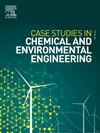采用人工神经网络与实验设计相结合的方法优化氧化铜矿浮选工艺
Q1 Environmental Science
Case Studies in Chemical and Environmental Engineering
Pub Date : 2024-12-13
DOI:10.1016/j.cscee.2024.101064
引用次数: 0
摘要
本研究解决了铜氧化物与氧化铁相关的表生带铜回收率低的挑战。建立了人工神经网络(ANN)模型,对氧化铜矿浮选工艺进行优化,准确率较高(R2 = 0.866)。Shapley值显示,硫化剂(NaHS)和捕收剂用量(PAX)对回收率影响最大,其中NaHS和铁对回收率有负影响,PAX和氧化铜含量对回收率有积极影响。在工业规模上验证了优化条件,铜回收率达到75.66%,矿物学分析证实了优化参数的有效性。本文章由计算机程序翻译,如有差异,请以英文原文为准。

Enhancing flotation of oxidized copper ores through the integration of artificial neural network and the design of experiments approach for process optimization
This study tackles the challenge of low copper recovery rates in supergene zones where copper oxides are associated with iron oxides. An artificial neural network (ANN) model was developed, achieving high accuracy (R2 = 0.866) to optimize flotation processes for oxidized copper ores. Shapley values ranked sulfidizing agent (NaHS) and collector dosage (PAX) as the most influential factors, with NaHS and iron negatively affecting recovery, while PAX and copper oxide content had positive effects. Optimal conditions were validated on an industrial scale, achieving 75.66 % copper recovery, confirming the effectiveness of the optimized parameters through mineralogical analysis.
求助全文
通过发布文献求助,成功后即可免费获取论文全文。
去求助
来源期刊

Case Studies in Chemical and Environmental Engineering
Engineering-Engineering (miscellaneous)
CiteScore
9.20
自引率
0.00%
发文量
103
审稿时长
40 days
 求助内容:
求助内容: 应助结果提醒方式:
应助结果提醒方式:


